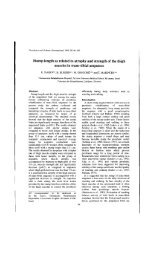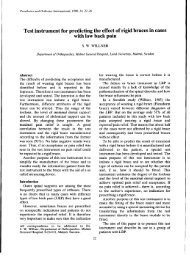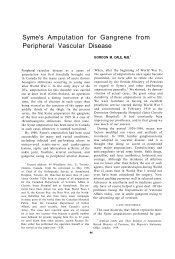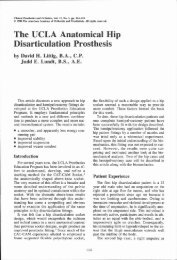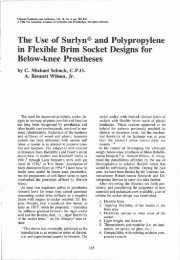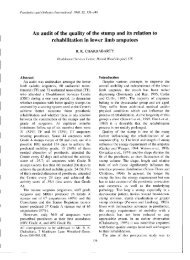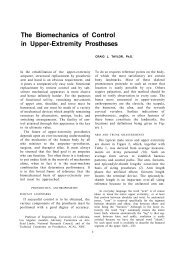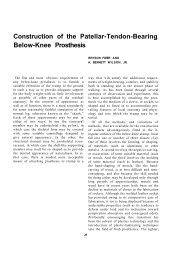Pro-Corn - O&P Library
Pro-Corn - O&P Library
Pro-Corn - O&P Library
Create successful ePaper yourself
Turn your PDF publications into a flip-book with our unique Google optimized e-Paper software.
cumulate, there is swelling of the soft tissue,<br />
and decreased range of motion of the joint. The<br />
inflamed synovium adjacent to the marginal<br />
bare areas causes destruction of bone, resulting<br />
in bony erosion at the margins. Because the inflamed<br />
synovium, known as the pannus, also<br />
proliferates, expansion occurs over the cartilage<br />
and destroys the cartilage through enzymatic<br />
action, producing symmetrical joint<br />
space narrowing. The pannus may also penetrate<br />
the unprotected bare bone and cause destruction<br />
of the cartilage from the marrow side.<br />
The reactive hyperemia, part of the inflammatory<br />
process, is implicated in the periarticular<br />
osteoporosis and the discontinuity of the subchondral<br />
bony plate. 2<br />
Joint destruction and deformities<br />
occur and become fixed as the weakened<br />
support structure of the ankle and foot<br />
gives way to the normal mechanical stresses<br />
placed upon it; changes in alignment of joints<br />
allow muscles, tendons, and ligaments that<br />
cross the joints to exert different forces, and<br />
stiffness and pain in the joints prevent mobility.<br />
3<br />
Clinical manifestations can include all joints<br />
of the ankle-foot, collectively or individually.<br />
Ankle involvement in rheumatoid arthritis is<br />
not as common as involvement of other joints<br />
of the foot. 5<br />
The clinical picture of ankle involvement<br />
is less dramatic than with the other<br />
joints, with swelling, stiffness, decreased range<br />
of motion, and pain being the indicators. Unlike<br />
the ankle, the hindfoot is often affected<br />
early in rheumatoid arthritis. The most common<br />
deformity of the hindfoot is pes planovalgus,<br />
or more simply, valgus of the hindfoot<br />
and flattening of the longitudinal arches. 5<br />
The<br />
midfoot-tarsal joints develop inflammatory<br />
changes that contribute to the pes planovalgus<br />
deformity of the hindfoot and midfoot. 5<br />
In<br />
time, each of the tarsal bones seem to be<br />
equally involved, causing loss of pronation-supination<br />
and malleability of the foot in general.<br />
The forefoot shows marked abnormalities on<br />
clinical and radiologic examination. The altered<br />
forces created by hindfoot and midfoot<br />
deformities act with the inflammatory process,<br />
affecting the metatarsal-phalangeal (MTP)<br />
joints and proximal interphalangeal (PIP) joints<br />
to give the typical findings of hallux valgus,<br />
claw toes, subluxation and depression of the<br />
metatarsal-phalangeal joints, abduction of the<br />
forefoot, and splay foot. Involvement here as in<br />
other parts of the foot is symmetric and increases<br />
with disease duration. 5<br />
Figure 2. Schematic view showing the effects of claw toes with subluxed MTP<br />
joints, resulting in metatarsal head prominences on the plantar surfaces of the foot.



